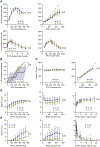Distinct firing responses to synthetic synaptic currents in the adult murine reticular and relay thalamus
- PMID: 40132223
- PMCID: PMC12395934
- DOI: 10.1152/jn.00052.2025
Distinct firing responses to synthetic synaptic currents in the adult murine reticular and relay thalamus
Abstract
Numerous cortical and subcortical inputs innervate the thalamus and robustly control thalamic activity. These synaptic inputs differ in shape and undergo dynamic changes throughout development and disease conditions. How the shape of postsynaptic currents regulates thalamic neuronal firing has been studied mainly in young rodents with immature neural development and function. Here, we use adult mice with mature intrinsic excitability to address this question in two compartments of the thalamus-the nucleus reticularis thalami (nRT) and thalamocortical (TC) relay nuclei. Using whole cell patch-clamp electrophysiology, we simulated synthetic inhibitory (IPSCs) and synthetic excitatory postsynaptic currents (EPSCs), injected them in nRT and TC neurons, and examined how changes in their shape parameters regulated neuronal firing in different electrical states. We found that in response to synthetic IPSCs, TC neurons initiate low-threshold spikes (LTSs) earlier than nRT neurons, and the amplitude of IPSCs regulates the probability of initiating an LTS while the duration of IPSCs regulates the timing at which the LTS initiates. These results show that in the adult thalamus, LTS is regulated by IPSCs similarly to what has been reported for the immature thalamus. In addition, sharp driver-like EPSCs evoke more firing when nRT and TC neurons are silent; whereas slow modulator-like EPSCs evoke more firing when nRT and TC neurons are active. Critically, we have generated a quantitative map of how features of synaptic currents shape neuronal firing in relationship with activity states.NEW & NOTEWORTHY We provide a systematic overview of how the shape parameters (i.e., amplitude, duration, and charge) of synthetic inhibitory and excitatory synaptic currents regulate neuronal firing in the adult murine thalamus across cell types (nRT vs. TC neurons) and electrical states (active vs. silent).
Keywords: circuits; electrophysiology; patch clamp; thalamus.
Conflict of interest statement
DISCLOSURES
No conflicts of interest, financial or otherwise, are declared by the authors.
Figures





References
-
- Clemente-Perez A, Makinson SR, Higashikubo B, Brovarney S, Cho FS, Urry A, Holden SS, Wimer M, Dávid C, Fenno LE, Acsády L, Deisseroth K, Paz JT. Distinct thalamic reticular cell types differentially modulate normal and pathological cortical rhythms. Cell Rep 19: 2130–2142, 2017. doi: 10.1016/j.celrep.2017.05.044. - DOI - PMC - PubMed
MeSH terms
Grants and funding
LinkOut - more resources
Full Text Sources

